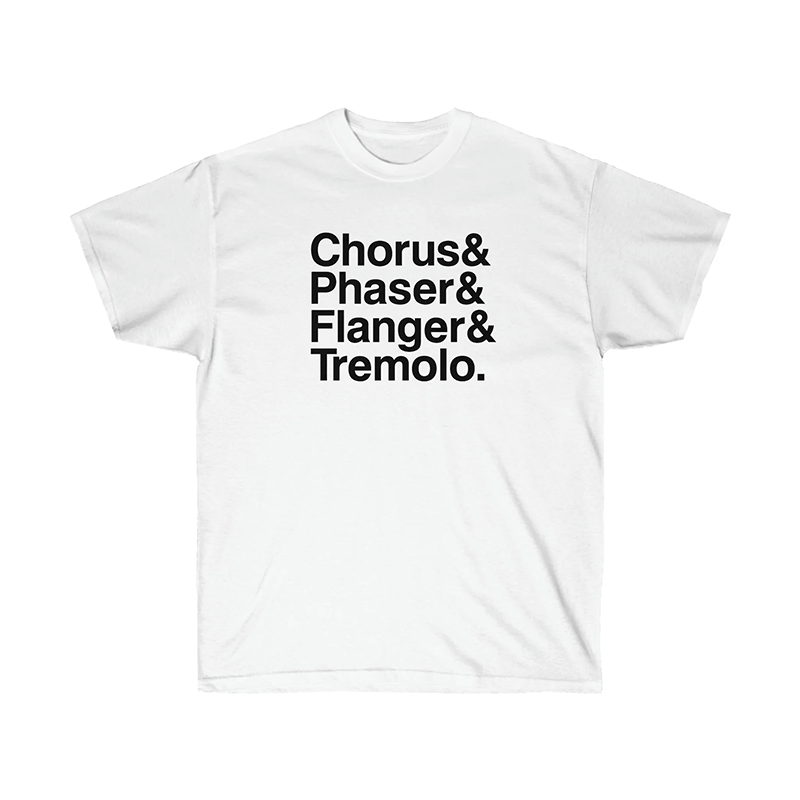Joshua Scott
Kansas City
JHS Pedals
www.jhspedals.com
Instagram @jhspedals
Twitter @jhspedals
Facebook @jhspedals
How long have you been a musician? How did you get into it in the first place?
I got into guitar when I was about 14, I think. I can’t remember the year, but I was young enough to be in junior High. My brother, who is ten years older, had the biggest cassette tape collection on God’s green earth. I was at his apartment, and I’d never really cared about music, but I saw some cassette tapes and started popping them in and out. There was a lot of stuff like The Cure, or Depeche Mode, and it had some 90’s stuff as well. But then there was one particular one, which was Pearl Jam “Ten” and it popped on and was on the side with the song “Alive” and I was just fascinated with how that song sounded. I went home, right after that, and started begging my mother for a guitar. She didn’t know what to get or buy so she went to Sam’s Club and bought a red, Stratocaster rip-off that came with an amp. The brand was Synsonics. So I’ve been a musician ever since. I think it took me two years to figure out to tune the guitar. And here we are.
Who have been some of your major musical influences, past or present?
So my musical influences are all over the place. I love guitar, but I get tired of guitar. Also, I just like good songwriting. I’m not somebody that just sits around and listens to shredder guitar players all the time. It kind of annoys me, mostly. Some of them are awesome, and then…
Mostly I just like rock music. But I love jazz, so I listen to them too. Some of my favorite artists are John Coltrane and Bob Dylan. I love Pearl Jam still. I love all kinds of stuff from all over the place. I love a lot of shoegaze stuff, like Sonic Youth. I listen to everything. I love bluegrass. Yeah, just tons of music.
What led to the start of JHS Pedals? How long have you been in business? How big is your operation/how many employees do you have?
So JHS is in it’s tenth year, which is amazing. I never thought that would happen. We have about 25 employees. It all started when I fixed a broken Boss pedal. It was a very simple fix. I was a guitar player, obviously, and had some pedals. One broke, so I fixed it. I just got really fascinated with how circuits worked. I’ve always been a little obsessive. I’m one-track minded, I would say. I do one thing at a time and I usually go overboard with it. So when I played basketball, that’s all I did. When I played guitar in bands, that all I did. So I got into pedals and that’s all I do.
Did you have formal schooling, or are you self-taught? Take us through that story:
I have no formal schooling. I graduated from a K-12 High School in the middle of a farm country part of Alabama. I hated school. I went to a semester of community college where I was scholarshipped, because I played a song, for a scholarship, on my guitar. I did that just to live in the dorm room and got some money. I think I bought a guitar with some of my money I should have bought books with. Basically, I just played cards all day and then I dropped out. That’s my education.
As far as pedals, when I got into it, I’ve always been more of a hands-on person, with anything. So guitar lessons, when I took them, made me hate guitar. When I got away from them, I loved guitar when I got into it by myself. The same with most anything. So it’s been the same with learning small signal electronics. I break a lot of things, and read a lot of book. I put myself through my own kind of challenges. So I’ll say “This month I’m going to study Op amplifiers.” So I study those. Or this month I’m going to do “this” or try to design a pedal that does “this.” So, I’m very self-taught.
What drives you as far as new pedal creation is concerned? How long does it typically take for an idea to come full circle and become a demo pedal? What’s the process behind new gear, and the eventual release of it to the public?
An idea usually takes about 12 months from the point that I actually start working on the breadboard. The breadboard is a device where you can, kind of, plug and play and create circuits. Think of it as the legos of circuitry. So you go and create your little recipe and bake something up on the breadboard. If I actually start one, to the end, it’s about 12 months before we start making them. We create a pedal, we prototype it, verify it, between schematic drawings, PCB layout and mechanical engineering, parts supply and dealer chain, preparation…I mean, it takes a while. Nothing moves fast. It’s kind of like turning a ship. The last release, the VCR, we sold a thousand right off the bat. So we have to prepare to build large volumes now, so that’s part of why it takes so long.
We’re pretty secretive on the stuff that is in the development part of the process and we try to only show things to the public when it’s ready to ship, because that saves us the trouble of explaining why something is not ready. Take the SeeSaw. “When’s the SeeSaw going to be ready?” I hear that every day, about five times. That’s a good example about why we don’t tell people anything until something is done.
What are some of the biggest concerns facing your profession today?
The biggest concern facing my profession is probably…I really don’t know that there is a concern. I don’t think I have one. I would say the challenges are to do things that are new. There are only so many things you can do with electronics. I think that’s why a lot of people are getting into digital signal processing. It’s a little more flexible so I think a lot of pedal guys, if you’re not innovating, you get left behind, in certain aspects. I think that’s a challenge for pedal guys nowadays.
The gear industry, as a whole, I think, has it’s ups and downs, but overall it seems to be doing pretty well.
Where do you see pedal building going in the future?
I am convinced that it all just goes around in circles. If you look at the 50’s and 60’s, we had the tube amps that came from tube radios. Leo Fender took basic tube amplifier text-book stuff and made it where you could plug a guitar in, with a speaker. Down the line, everyone said “Let’s get rid of these tubes and do solid state.” Then we did solid state and people were probably asking “What’s the future of amps?” and they were saying “It’s solid state.” And then you roll back around and now everybody is playing tube amps again and some guys never left. So we’re back where we started because certain things just sound better. So I think the future of pedals will always be what we are doing right now and I think that certain eras and times will have creative spurts. You know, guys like Strymon and stuff are really breaking ground with digital and they will continue to do that and be around forever, I think. But there will always just be guys building really good, simple pedals. Other than that, I think people will ride the wave of technology in and out of that simple pedal thing.
Who are some of your favorite builders in the industry right now?
Luckily they are all friends, and that’s really great to be able to say. Robert Keeley, EarthQuaker Devices, Brian Wampler, Rick Matthews at Matthews Effects; there are so many. Philippe – his stuff is amazing. Caroline Guitar Company. Then people like Eventide and Strymon, yeah. There’s really not a bad pedal company out there. I mean, there probably is, but it’s hard to exist nowadays, if you aren’t doing really great stuff. Yeah, I’m really fortunate to be friends with a lot of these guys and be able to learn from them and swap off stories and stuff. That’s fun.
Name the last 5 records you listened to:
I don’t know. I’m looking through them now because I have to be accurate. The newest Slowdive record. There is a compilation record from the early 70’s called “Will the Circle be Unbroken” that’s kind of a bluegrass record and has all these classic guys like Earl Scruggs and Roy Acuff on it. The brand new Real Estate. I was listening to the new John Mayer as well. The new Feist. I got back into some Elliott Smith records, “Figure 8” being one of those. I’m listing more than five so I’ll stop. One more, “Benji” by Sun Kil Moon.
Klon hype: Love it or Hate it?
I love the Klon, not because other people love it, but because I have used it before it was popular. I bought my first Klon for about 200 bucks. I do not use them as clean boosts, like everyone else, I use it as a high-gain overdrive and I stack it with a Morning Glory. Probably, when I’m dying, that will be on my pedal board when I’m, like, 90 – those two pedals. I hope I live to be 90, that would be nice. I think it’s a great pedal and I think that Bill is a genius when it comes to getting attention to his product. I think the Klon looks amazing. I think his branding, the name, the entire package; he’s just genius at everything. The circuit is great. They are made like tanks. The new KTR sounds amazing.
I have every released version of the Klon and serial number 002, so I have the first production serial number. I believe that Bill has 001. I think that I might be the only person that has every version. I have the Silver Klon, the Silver with the Short-Tail Centaur, then the Long-Tail Centaur, I have the Gold Klon, the Gold Klon with the Short-Tailed Centaur, the Gold Klon with the Long-Tail Centaur and then I have the other unit, which is Gold 002.
Any last comments, or anything you’d like to talk about?
I would just like to thank everyone who has supported us over the years. I want you to know that we love to talk to you. Reach out to us on our social media platforms. I gave those addresses earlier. Message us. Tag us. Ask us questions. We are here for you. That’s all. Have a great day, and I really enjoy Pedal of the Day. Thanks for having me in this interview!
Thanks so much to Josh for taking the time to answer some questions! Make sure to go check out www.jhspedals.com to peruse all of their gear – Cheers!
GET EXCLUSIVE UPDATES, CONTEST INFO, SEE OUR LATEST DEMO VIDEOS AND MORE:




















